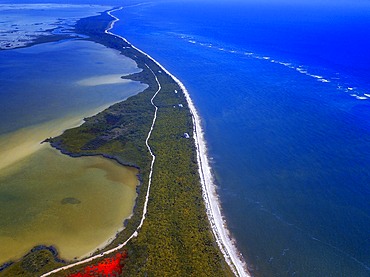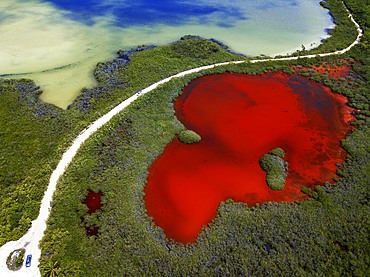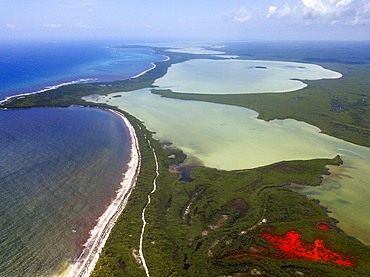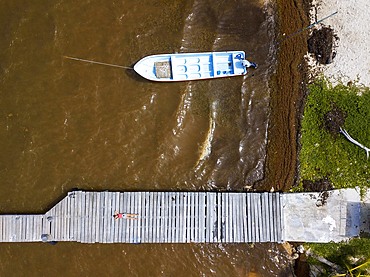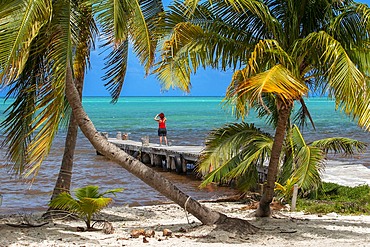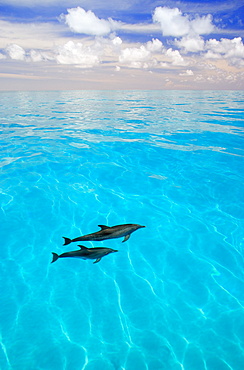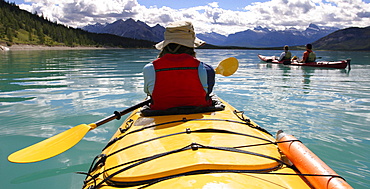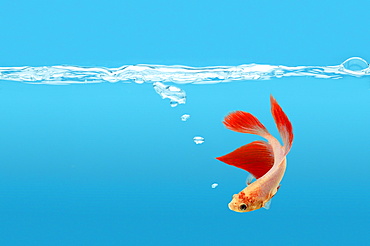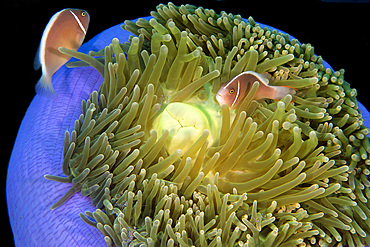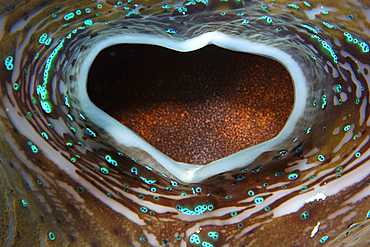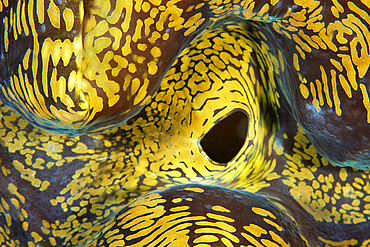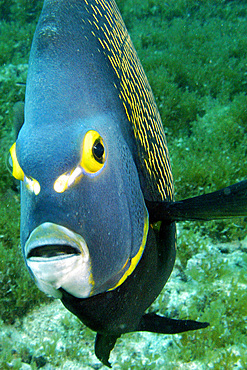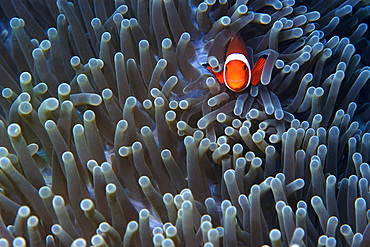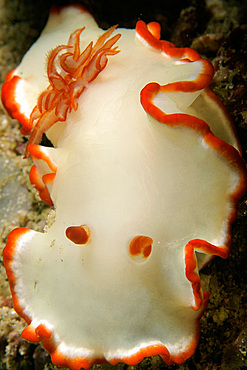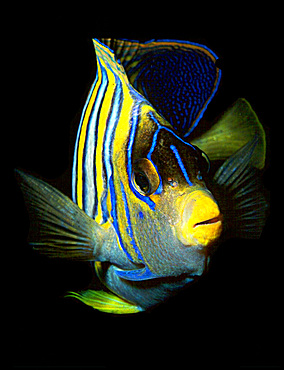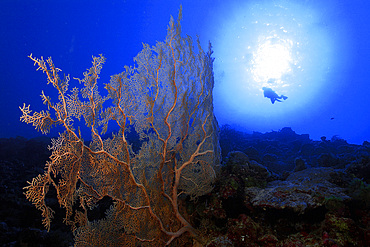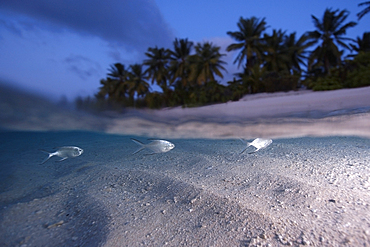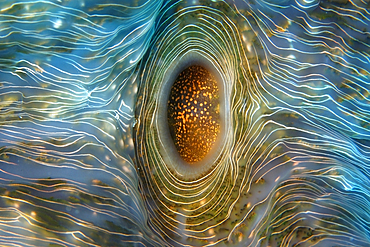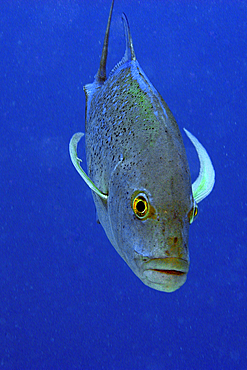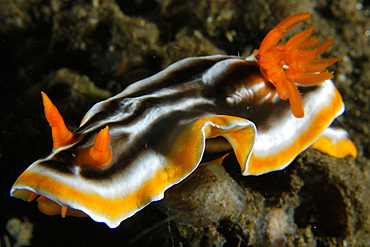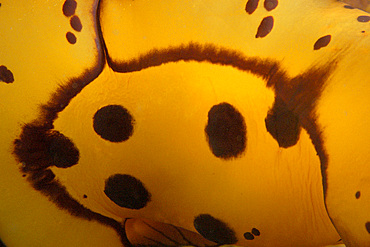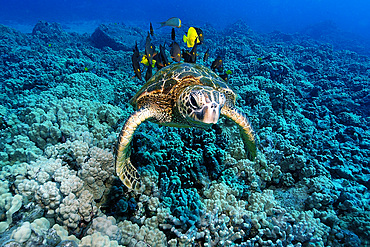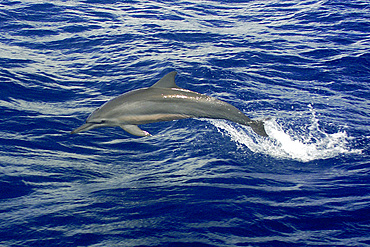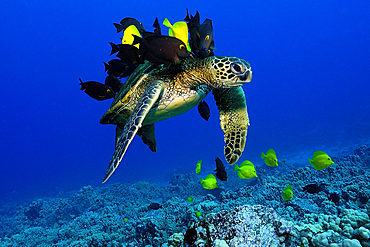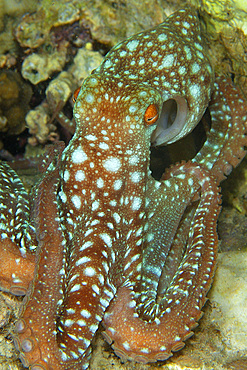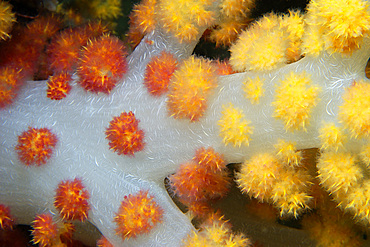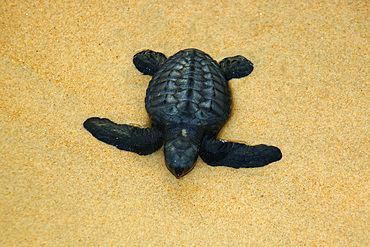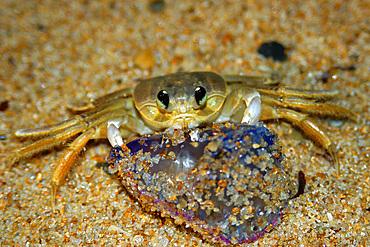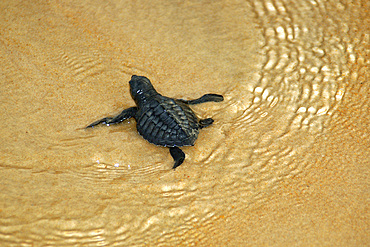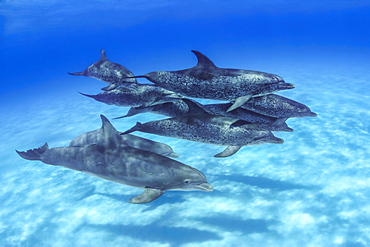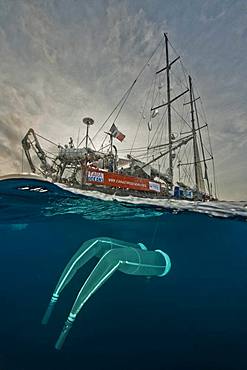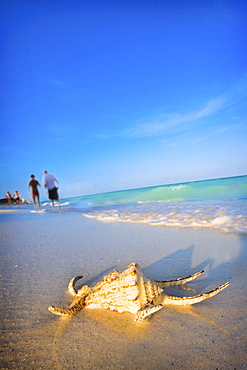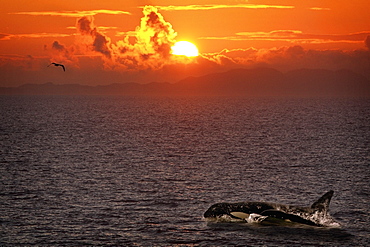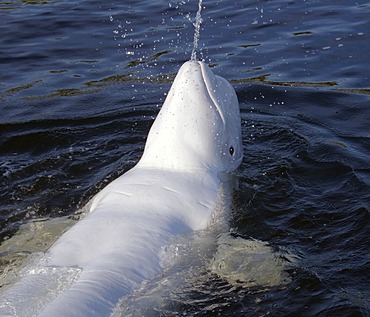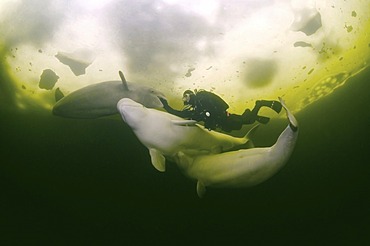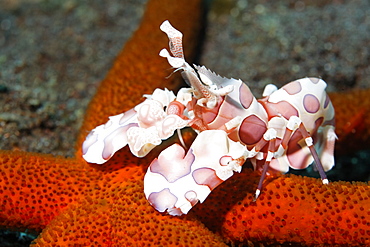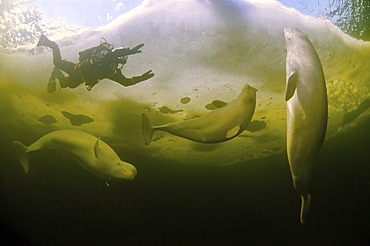Recent searches
Loading...
1112-8343 - Abundant marine life in the clear waters off Bangka Island, near Manado, Sulawesi, Indonesia, Southeast Asia, Asia
1350-6627 - Aerial view of Punta Allen Sian Ka'an Reserve, Yucatan Peninsula, Mexico. Red lagoon near Boca Paila Bridge.
In the language of the Mayan peoples who once inhabited this region, Sian Ka'an means Origin of the Sky. Located on the east coast of the Yucatán peninsula, this biosphere reserve contains tropical forests, mangroves and marshes, as well as a large marine section intersected by a barrier reef. It provides a habitat for a remarkably rich flora and a fauna comprising more than 300 species of birds, as well as a large number of the region's characteristic terrestrial vertebrates, which cohabit in the diverse environment formed by its complex hydrological system.
Along its roughly 120 kilometres of coastline, the property covers over 400,000 hectares of land ranging from sea level to only ten m.a.s.l. The property boasts diverse tropical forests, palm savannah, one of the most pristine wetlands in the region, lagoons, extensive mangrove stands, as well as sandy beaches and dunes. The 120,000 hectares of marine area protect a valuable part of the Mesoamerican Barrier Reef and seagrass beds in the shallow bays. The lush green of the forests and the many shades of blue of the lagoons and the Caribbean Sea under a wide sky offer fascinating visual impressions.
1350-6623 - Aerial view of Punta Allen Sian Ka'an Reserve, Yucatan Peninsula, Mexico. Red lagoon near Boca Paila Bridge.
In the language of the Mayan peoples who once inhabited this region, Sian Ka'an means Origin of the Sky. Located on the east coast of the Yucatán peninsula, this biosphere reserve contains tropical forests, mangroves and marshes, as well as a large marine section intersected by a barrier reef. It provides a habitat for a remarkably rich flora and a fauna comprising more than 300 species of birds, as well as a large number of the region's characteristic terrestrial vertebrates, which cohabit in the diverse environment formed by its complex hydrological system.
Along its roughly 120 kilometres of coastline, the property covers over 400,000 hectares of land ranging from sea level to only ten m.a.s.l. The property boasts diverse tropical forests, palm savannah, one of the most pristine wetlands in the region, lagoons, extensive mangrove stands, as well as sandy beaches and dunes. The 120,000 hectares of marine area protect a valuable part of the Mesoamerican Barrier Reef and seagrass beds in the shallow bays. The lush green of the forests and the many shades of blue of the lagoons and the Caribbean Sea under a wide sky offer fascinating visual impressions.
1350-6625 - Aerial view of Punta Allen Sian Ka'an Reserve, Yucatan Peninsula, Mexico. Red lagoon near Boca Paila Bridge.
In the language of the Mayan peoples who once inhabited this region, Sian Ka'an means Origin of the Sky. Located on the east coast of the Yucatán peninsula, this biosphere reserve contains tropical forests, mangroves and marshes, as well as a large marine section intersected by a barrier reef. It provides a habitat for a remarkably rich flora and a fauna comprising more than 300 species of birds, as well as a large number of the region's characteristic terrestrial vertebrates, which cohabit in the diverse environment formed by its complex hydrological system.
Along its roughly 120 kilometres of coastline, the property covers over 400,000 hectares of land ranging from sea level to only ten m.a.s.l. The property boasts diverse tropical forests, palm savannah, one of the most pristine wetlands in the region, lagoons, extensive mangrove stands, as well as sandy beaches and dunes. The 120,000 hectares of marine area protect a valuable part of the Mesoamerican Barrier Reef and seagrass beds in the shallow bays. The lush green of the forests and the many shades of blue of the lagoons and the Caribbean Sea under a wide sky offer fascinating visual impressions.
1350-6620 - Aerial view of Punta Allen Sian Ka'an Reserve, Yucatan Peninsula, Mexico. Red lagoon near Boca Paila Bridge.
In the language of the Mayan peoples who once inhabited this region, Sian Ka'an means Origin of the Sky. Located on the east coast of the Yucatán peninsula, this biosphere reserve contains tropical forests, mangroves and marshes, as well as a large marine section intersected by a barrier reef. It provides a habitat for a remarkably rich flora and a fauna comprising more than 300 species of birds, as well as a large number of the region's characteristic terrestrial vertebrates, which cohabit in the diverse environment formed by its complex hydrological system.
Along its roughly 120 kilometres of coastline, the property covers over 400,000 hectares of land ranging from sea level to only ten m.a.s.l. The property boasts diverse tropical forests, palm savannah, one of the most pristine wetlands in the region, lagoons, extensive mangrove stands, as well as sandy beaches and dunes. The 120,000 hectares of marine area protect a valuable part of the Mesoamerican Barrier Reef and seagrass beds in the shallow bays. The lush green of the forests and the many shades of blue of the lagoons and the Caribbean Sea under a wide sky offer fascinating visual impressions.
1350-6616 - Aerial view of Punta Allen Sian Ka'an Reserve, Yucatan Peninsula, Mexico.
In the language of the Mayan peoples who once inhabited this region, Sian Ka'an means Origin of the Sky. Located on the east coast of the Yucatán peninsula, this biosphere reserve contains tropical forests, mangroves and marshes, as well as a large marine section intersected by a barrier reef. It provides a habitat for a remarkably rich flora and a fauna comprising more than 300 species of birds, as well as a large number of the region's characteristic terrestrial vertebrates, which cohabit in the diverse environment formed by its complex hydrological system.
Along its roughly 120 kilometres of coastline, the property covers over 400,000 hectares of land ranging from sea level to only ten m.a.s.l. The property boasts diverse tropical forests, palm savannah, one of the most pristine wetlands in the region, lagoons, extensive mangrove stands, as well as sandy beaches and dunes. The 120,000 hectares of marine area protect a valuable part of the Mesoamerican Barrier Reef and seagrass beds in the shallow bays. The lush green of the forests and the many shades of blue of the lagoons and the Caribbean Sea under a wide sky offer fascinating visual impressions.
1350-6615 - Palms and old pier in Punta Allen Sian Ka'an Reserve, Yucatan Peninsula, Mexico.
In the language of the Mayan peoples who once inhabited this region, Sian Ka'an means Origin of the Sky. Located on the east coast of the Yucatán peninsula, this biosphere reserve contains tropical forests, mangroves and marshes, as well as a large marine section intersected by a barrier reef. It provides a habitat for a remarkably rich flora and a fauna comprising more than 300 species of birds, as well as a large number of the region's characteristic terrestrial vertebrates, which cohabit in the diverse environment formed by its complex hydrological system.
Along its roughly 120 kilometres of coastline, the property covers over 400,000 hectares of land ranging from sea level to only ten m.a.s.l. The property boasts diverse tropical forests, palm savannah, one of the most pristine wetlands in the region, lagoons, extensive mangrove stands, as well as sandy beaches and dunes. The 120,000 hectares of marine area protect a valuable part of the Mesoamerican Barrier Reef and seagrass beds in the shallow bays. The lush green of the forests and the many shades of blue of the lagoons and the Caribbean Sea under a wide sky offer fascinating visual impressions.
1350-6611 - Underwater close up view of open coral polyp during a dive, Cancun, Quintana Roo, Mexico
1116-52414 - Siamese Fighting Fish (Betta Splendens)
1350-2560 - Pink anemone fish, Amphiprion periderion, on magnificent sea anemone, Heteractis magnifica, Dumaguete, Negros, Philippines.
1350-2445 - Coral reef during low tide in lagoon, Mili, Marshall Islands (N. Pacific).
1350-2481 - Giant clam, Tridacna gigas, siphon detail, Rongelap, Marshall Islands, Micronesia
1350-2455 - Fluted giant clam, Tridacna squamosa, siphon detail, Namu atoll, Marshall Islands (Pacific).
1350-2428 - Green sea turtle, Chelonia mydas, Kailua-Kona, Hawaii, (Pacific)
1350-2344 - French angelfish, Pomacanthus paru, Ilha rata, Fernando de Noronha national marine sanctuary, Pernambuco, Brazil (S. Atlantic)
1350-2473 - Red (Lace) coral, Distichopora violacea, feather stars, and juvenile gray reef shark, Carcharhinus amblyrhynchos, Ailuk atoll, Marshall Islands, Pacific
1350-2571 - Hawaiian reef lobster, endemic, Enoplometopus occidentalis, Portlock, Oahu, Hawaii (N. Pacific)
1350-2465 - Whitetip reef shark, Triaenodon obesus, Namu atoll, Marshall Islands (N. Pacific).
1350-2443 - Brown algae, Sargassum horneri and Undaria pinnatifida, Chusan, Ulleungdo, South Korea (East Sea or Sea of Japan).
1350-2537 - Common lionfish, Pterois volitans, close-up, Sabang wreck, Puerto Galera, Mindoro, Philippines.
1350-2521 - False clown anemone fish, Amphiprion ocellaris, Dauin, Dumaguete, Negros, Philippines.
1350-2530 - Broadband cuttlefish, Sepia latimanus, in sandy bottom, Gato Island, Cebu, Philippines.
1350-2548 - Dorid nudibranch, Glossodoris averni, La Laguna, Puerto Galera, Mindoro, Philippines.
1350-2553 - Ornate ghost pipefish, Solenostomus paradoxus, Dumaguete, Negros Island, Philippines.
1350-2580 - Regal angelfish, Pygoplites diacanthus, Hideaway island, Port Vila, Vanuatu.
1350-2456 - Fan coral, Subergorgia sp., and diver silhouette against he sun, Namu atoll, Marshall Islands (N. Pacific).
1350-2575 - Pink anemonefish on sea anemone, Amphiprion periderion, Rongelap, Marshall Islands (N. Pacific).
1350-2556 - Ascidian, Didemnum molle, oscule detail, Dauin, Negros, Philippines.
1350-2486 - Split image of Smallspotted dart, Trachinotus baillonii, swimming along the sandy shore at dusk, Rongelap, Marshall Islands, Micronesia
1350-2574 - Beaked Whale stranded on coral reef during low tide, Mesoplodon sp., Mili, Marshall Islands (N. Pacific)..
1350-2454 - Saddled butterflyfish, Chaetodon ephippium, Namu atoll, Marshall Islands (N. Pacific).
1350-2484 - Horseshoe clam, Hippopus hippopus, Rongelap, Marshall Islands, Micronesia
1350-2579 - Juvenile and adult pink anemonefish in sea anemone, Amphiprion perideraion, Fila Reef, Port Vila, Vanuatu (S. Pacific).
1350-2472 - Bluefin trevally, Caranx melampygus, Ailuk atoll, Marshall Islands, Pacific
1350-2466 - Pair of wire coral gobies, Bryaninops yongei, on wire coral, Cirripathes anguina,Ailuk atoll, Marshall Islands, Pacific
1350-2583 - Bottlenose dolphin, Tursiops truncatus, Oahu, Hawaii (N. Pacific).
1350-2524 - Nudibranch, Chromodoris magnifica, Dumaguete, Negros Island, Philippines.
1350-2546 - Feather star, possibly Oxycomanthus bennetti, West Escarceo, Puerto Galera, Mindoro, Philippines.
1350-2532 - Mandarinfish, Synchiropus splendidus, male, Malapascua, Cebu, Philippines, Visayan Sea.
1350-2541 - Pleurobranch sidegill slug, Berthella martensi, mantle detail, Puerto Galera, Mindoro, Philippines.
1350-2427 - Green sea turtle, Chelonia mydas, gets cleaned by yellow tangs, Zebrasoma flavescens and lined bristletooth, Ctenochaetus striatus, Kailua-Kona, Hawaii, (N. Pacific)
1350-2449 - Spinner dolphin, Stenella longirostris, Namu atoll, Marshall Islands (N. Pacific).MID0042
1350-2511 - Family of false clown anemone fish, Amphiprion ocellaris, seeking refuge in sea anemone, Masaplod, Dumaguete, Negros Island, Philippines.
1350-2460 - Pink hydrocoral (lace coral), Stylaster sp., Namu atoll, Marshall Islands (N. Pacific).
1350-2426 - Green sea turtle, Chelonia mydas, gets cleaned by yellow tangs, Zebrasoma flavescens and lined bristletooth, Ctenochaetus striatus, Kailua-Kona, Hawaii, (N. Pacific)
1350-2504 - Family of false clown anemone fish, Amphiprion ocellaris, seeking refuge in sea anemone, Dumaguete, Negros Island, Philippines.
1350-2513 - Common lionfish, Pterois volitans, blends in with a variety of soft corals and sponges, Cars, Dumaguete, Negros Island, Philippines.
1350-2534 - Starry night octopus, Octopus luteus, foraging on coral reef at night, Malapascua, Cebu, Philippines, Visayan Sea.
1350-2512 - Family of false clown anemone fish, Amphiprion ocellaris, seeking refuge in sea anemone, Masaplod, Dumaguete, Negros Island, Philippines.
1350-2505 - Anemone fish, Amphiprion sp., Dumaguete, Negros Island, Philippines.
1350-2555 - Clark's anemonefish, Amphiprion clarkii, unusual color variant, male, Dauin, Negros, Philippines..
1350-2474 - Reef octopus, Octopus cyanea, eye and siphon detail, Rongelap, Marshall Islands, Micronesia
1350-2467 - Cushion star, Culcita novaguineae, skin texture, Ailuk atoll, Marshall Islands, Pacific
1350-2531 - Soft coral, Dendronephthya sp., Lapus Lapus Island marine park, Malapascua, Cebu, Philippines.
1350-2577 - Pink anemonefish, Amphiprion perideraion, in sea anemone, Great barrier reef marine park, Australia (South Pacific).
1350-2471 - Wave breaking over shallow coral reef, Ailuk atoll, Marshall Islands, Pacific
1350-2554 - Pair of false clown anemonefish, Amphiprion ocellaris, in anemone, Daiun, Negros, Philippines.
1350-2515 - False clown anemone fish, Amphiprion ocellaris, Dauin, Dumaguete, Negros Island, Philippines.
1350-2509 - Nudibranch, Atlantis house reef, Dumaguete, Negros Island, Philippines.
1350-2518 - Needle cuttlefish, Sepia aculeata, front view at night, Dumaguete, Negros Island, Philippines.
1350-2318 - Olive ridley turtle hatchling, Lepidochelys olivacea, Costa do Sauipe, Bahia, Brazil (South Atlantic)
1350-2316 - Crab preying on dead portuguese man-of-war, Physalia physalis, Praia do Forte, Bahia, Brazil (South Atlantic)
1350-2315 - Porco's bay and Dois Irmaos islands, Fernando de Noronha national marine sanctuary, Pernambuco, Brazil (S. Atlantic)
1350-2317 - Olive ridley turtle hatchling, Lepidochelys olivacea, Costa do Sauipe, Bahia, Brazil (South Atlantic)
1350-2314 - Green sea turtles hatching, Chelonia mydas, Fernando de Noronha, Pernambuco, Brazil.
1116-49706 - Mr. Fleetham spent an afternoon photographing these Atlantic Spotted Dolphin (Stenella plagiodon). During the several hours in the water a group of Atlantic Bottlenose Dolphin (Tursiops truncates) joined the company for nearly an hour of inter-species exchange, Bahamas
746-89349 - Oasis Biderrosa, Orosei, Sardinia, Italy, Europe
1116-47087 - A Set Of Two Rare Hawaiian Sunrise Scallop Seashells, Also Known As Pecten Langfordi, In The Sand At Lanikai Beach, Honolulu, Oahu, Hawaii, United States Of America
1116-47088 - A Red Live Finger Starfish, Also Known As Linckia Sea Star, Found Along A Sandy Beach With White Ocean Tide Washing Up, Honolulu, Oahu, Hawaii, United States Of America
1116-47200 - Detail View Of A Sea Star In A Tidal Pool, Hesketh Island, Homer, Southcentral Alaska, USA
860-287450 - Tara Oceans Expeditions - May 2011. Tara with deployed plancton nets. On "station", the boat is drifting without engine or sails. Tara Oceans, a unique expedition: Tara Oceans is the very first attempt to make a global study of marine plankton, a form of sea life that includes organisms as small as viruses and bacterias, and as big as medusas. Our goal is to better understand planktonic ecosystems by exploring the countless species, learning about interactions among them and with their environment. Marine plankton is the only ecosystem that is almost continuous over the surface of the Earth. Studying plankton is like taking the pulse of our planet. Recently, scientists have discovered the great importance of plankton for the climate: populations of plankton are affected very rapidly by variations in climate. But in turn they can influence the climate by modifying the absorption of carbon. In a context of rapid physico-chemical changes, for example the acidification observed today in the world's oceans, it is urgent to understand and predict the evolution of these particular ecosystems. Finally, plankton is an astonishing way of going back in time ? a prime source of fossils. Over the eons, plankton has created several hundred meters of sediment on the ocean floors. This allows us to go back in time, to the first oceans on Earth, and better understand the history of our biosphere. More than 12 fields of research are involved in the project, which will bring together an international team of oceanographers, ecologists, biologists, geneticists, and physicists from prestigious laboratories headed by Eric Karsenti of the European Molecular Biology Laboratory. Galapagos
1116-42681 - Whale Watching From A Scenic Spot, Makapuu, Oahu, Hawaii, United States Of America
1116-41974 - The lion's mane jellyfish (cyanea capillata) is the largest known species of jellyfish in the pacific ocean on coastal british columbia, British columbia canada
1116-39730 - Colourful coral reef and schooling fish, Hawaii, United States of America
1116-39940 - A close look at the eggs of a common anemonefish (Amphiprion perideraion) that is most often found associated with the anemone, Heteractis magnifica, Philippines.
1116-39947 - A close look at the eggs of a common anemonefish (Amphiprion perideraion) that is most often found associated with the anemone, Heteractis magnifica, Philippines.
1116-39938 - Mouth detail of a colorful and healthy mushroom coral (Fungia fungites) that is growing on a tropical coral reef. Mushroom coral is unique in the coral world, in that it does not attach itself to the bottom, Philippines
1174-4679 - Divers observe marine life attached to the remnants of the hull of a shipwreck dive site.
1174-4654 - Marine life, fish in the waters of the South Pacific. A grey reef shark among a humpback red snapper shoal.
832-375007 - Beluga whale (Delphinapterus leucas), Kareliya, Russia, White Sea, Arctic
832-372294 - Pacific seahorse (Hippocampus ingens) and a small sponge, Ponta de Sao Vicente, Isabella Island, Albemarle, Galapagos Islands, a UNESCO World Natural Heritage Site, Ecuador, Pacific Ocean
832-372288 - Shoal of golden cownose rays (Rhinoptera steindachneri), swimming in the open sea, Gardner Bay, Española Island also known as Hood Island, Galápagos Islands, a World Heritage - natural site, Ecuador, South America, Pacific Ocean
832-372297 - Pygmy seahorse (Bargibanti hippocampus) on a branch of coral, Great Barrier Reef, a UNESCO World Heritage Site, Queensland, Cairns, Australia, Pacific Ocean
832-373802 - Three Common Bottlenose Dolphins (Tursiops truncatus), adult, leaping at sunset, Roatan, Honduras, Caribbean, Central America, Latin America
832-367281 - Diver and Belugas, White whales (Delphinapterus leucas), ice-diving in White Sea, Karelia, north Russia, Arctic
832-367923 - Steller sea lion (Eumetopias jubatus), bull, swimming, California, USA
832-373800 - Two Common Bottlenose Dolphins (Tursiops truncatus), adult, leaping at sunset, Roatan, Honduras, Caribbean, Central America, Latin America
832-372296 - Harlequin shrimp (Hymenocera picta) on a red starfish, Great Barrier Reef, a UNESCO World Heritage Site, Queensland, Cairns, Australia, Pacific Ocean
832-367282 - Diver and Belugas, White whales (Delphinapterus leucas), ice-diving in White Sea, Karelia, north Russia, Arctic
832-371974 - Tourist playing with a common bottlenose dolphin (Tursiops truncatus), dolphin show, Hawks Cay Resort, Florida Keys, USA

